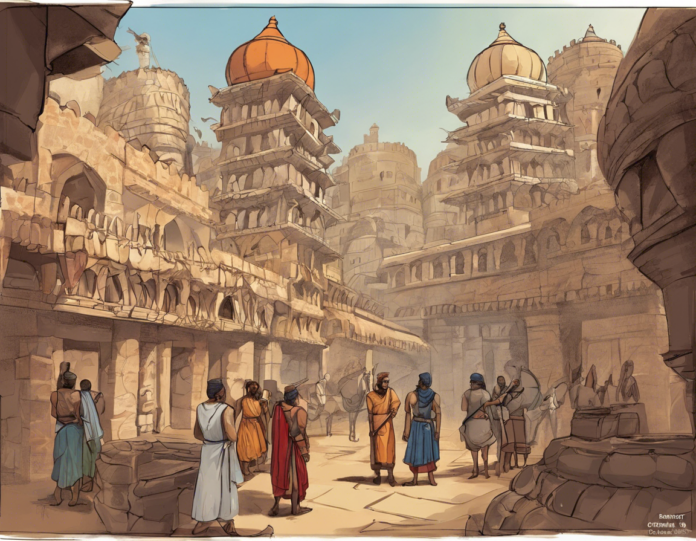Satish Chandra, an eminent historian of medieval India, is renowned for his seminal work in the field of Indian history. His extensive research has brought to light the rich tapestry of India’s medieval past, unraveling the complexities of governance, society, culture, and economy during this intriguing period. In this comprehensive guide, we delve into the world of Medieval India through the lens of Satish Chandra’s scholarly work, offering an in-depth exploration of the key themes and developments that characterized this era.
Historical Context and Key Features
Medieval India spans roughly from the 8th century to the 18th century, a period marked by significant political, social, and cultural transformations. Satish Chandra’s nuanced analysis sheds light on the diverse dynasties and empires that ruled over the Indian subcontinent, from the Delhi Sultanate to the Mughal Empire. His research highlights the complex interplay between various religious, linguistic, and regional identities, providing a holistic understanding of India’s medieval history.
Political Dynamics and Administrative Structures
One of the central themes of Satish Chandra’s work is the examination of political structures and governance in medieval India. He elucidates the evolution of statecraft, the role of kings and nobles, and the intricate mechanisms of revenue administration. Chandra’s meticulous research reveals the challenges faced by rulers in maintaining territorial integrity and managing diverse populations, offering valuable insights into the power dynamics of the time.
Socio-Cultural Milieu: Religion, Society, and Art
Religion played a pivotal role in shaping medieval Indian society, with Hinduism, Islam, Buddhism, and Jainism coexisting and interacting in complex ways. Satish Chandra’s scholarship delves into the religious syncretism, artistic patronage, and social hierarchies prevalent during this period. From the construction of magnificent temples and mosques to the flourishing of literature and art forms, Chandra’s exploration of the socio-cultural fabric of medieval India is both enlightening and enriching.
Economic Systems and Trade Networks
The economic history of medieval India is another area of expertise for Satish Chandra, who meticulously analyzes the agrarian economy, trade networks, and urban centers of the time. His research sheds light on the prosperity of merchant communities, the role of markets and fairs, and the impact of global trade on the Indian subcontinent. Chandra’s insights into the economic structures of medieval India offer a nuanced perspective on the interconnectedness of local and global economic systems.
Legacy and Contemporary Relevance
Satish Chandra’s work continues to be a cornerstone of medieval Indian history, shaping academic discourse and inspiring new generations of scholars. His holistic approach to historical research, incorporating political, social, cultural, and economic perspectives, has set a high standard for understanding India’s medieval past. By engaging with Chandra’s scholarship, enthusiasts of history and culture can gain a deeper appreciation of the legacies that have shaped contemporary India.
FAQs (Frequently Asked Questions)
- What were the major empires that ruled over medieval India?
-
The major empires that ruled over medieval India included the Delhi Sultanate, the Vijayanagara Empire, the Mughal Empire, and the Maratha Empire.
-
How did religion impact medieval Indian society?
-
Religion played a significant role in shaping medieval Indian society, with Hinduism, Islam, Buddhism, and Jainism influencing social norms, cultural practices, and political dynamics.
-
What were the key economic activities in medieval India?
-
Agriculture, trade, craftsmanship, and urban commerce were key economic activities in medieval India, with trade networks connecting the subcontinent to distant lands.
-
How did Satish Chandra contribute to the study of medieval Indian history?
-
Satish Chandra’s research enriched the study of medieval Indian history by offering nuanced insights into political structures, socio-cultural dynamics, economic systems, and the legacy of the period.
-
What are some recommended readings by Satish Chandra on medieval India?
-
Some recommended readings by Satish Chandra include “Medieval India: From Sultanat to the Mughals”, “Parties and Politics at the Mughal Court”, and “State, Economy and the Market in Early Indian Society”.
-
What role did art and architecture play in medieval India?
-
Art and architecture flourished in medieval India, with the construction of magnificent temples, mosques, forts, and palaces reflecting the artistic patronage of ruling elites and the cultural diversity of the period.
-
How did trade networks impact the economy of medieval India?
-
Trade networks, both overland and maritime, played a crucial role in connecting medieval India to regions such as Central Asia, the Middle East, Southeast Asia, and Europe, facilitating commerce, cultural exchange, and the movement of commodities.
-
What were the main social hierarchies in medieval Indian society?
-
Medieval Indian society was characterized by complex social hierarchies based on caste, class, religion, and gender, which influenced access to resources, opportunities, and social mobility.
-
What were some of the key architectural achievements of medieval India?
-
The medieval period in India witnessed the construction of iconic structures such as the Qutub Minar, Red Fort, Taj Mahal, Hampi’s Virupaksha Temple, and Khajuraho’s temples, showcasing the architectural diversity and artistic brilliance of the era.
-
How did the decline of medieval empires pave the way for the rise of regional powers in India?
- The decline of medieval empires such as the Mughals and the Marathas led to the emergence of regional powers and princely states in different parts of India, shaping the political landscape of the subcontinent in the following centuries.
In conclusion, Satish Chandra’s scholarly contributions have deepened our understanding of medieval India, offering a compelling narrative of the political, social, cultural, and economic dynamics that defined this fascinating period in Indian history. By exploring his research and engaging with the complexities of medieval India, enthusiasts can embark on a captivating journey through time, unraveling the threads of continuity and change that have shaped the Indian subcontinent.

